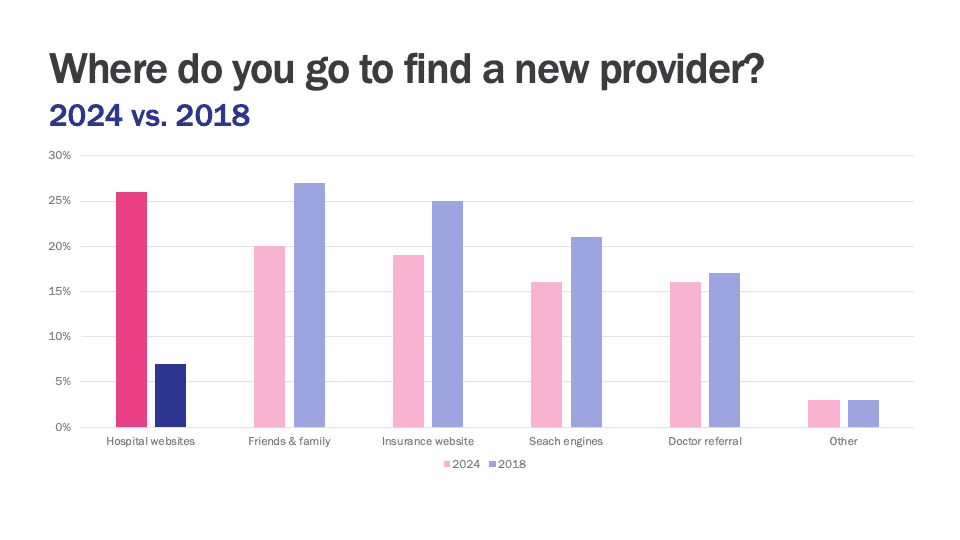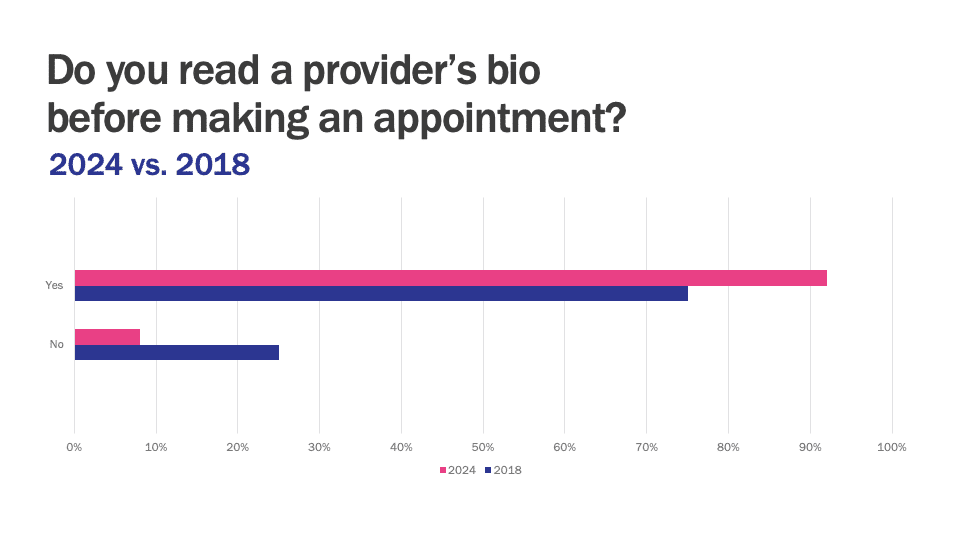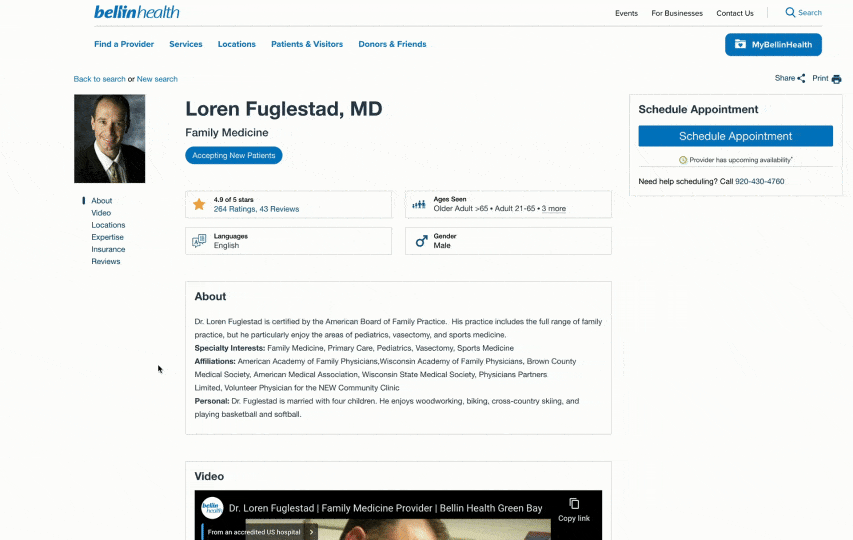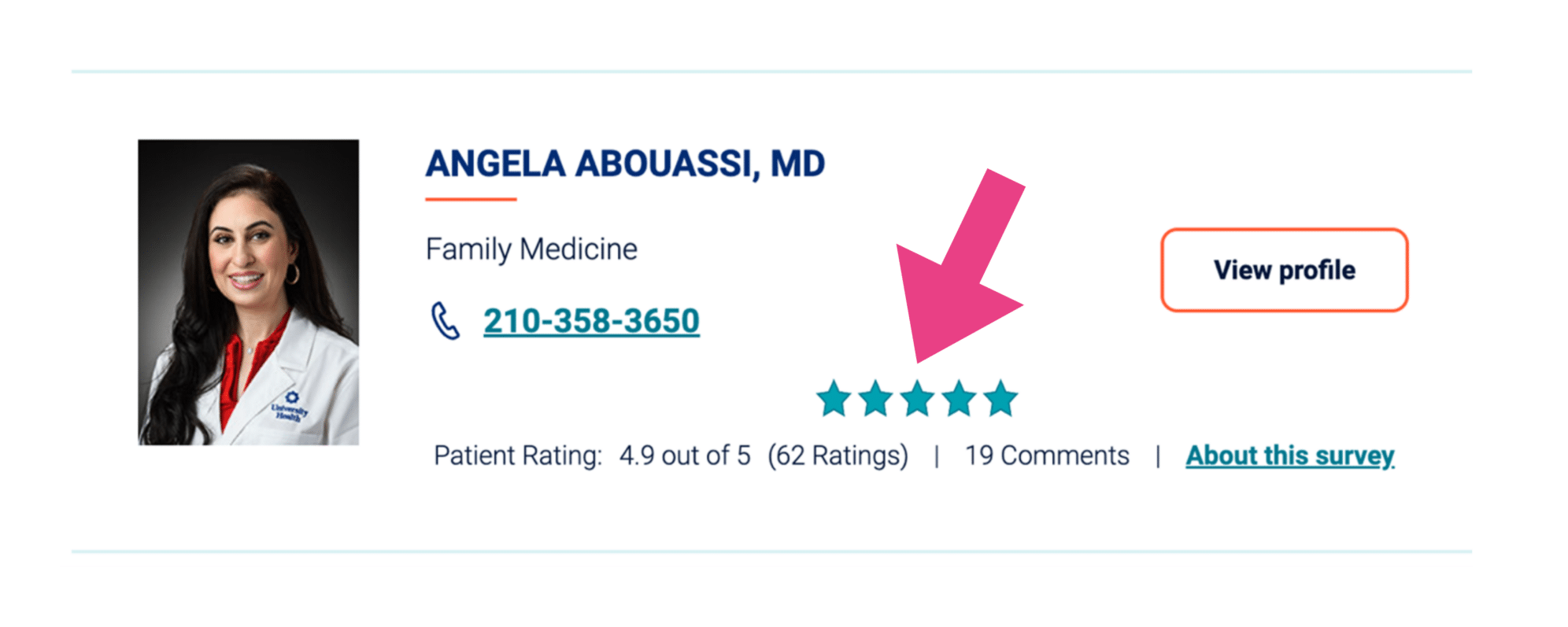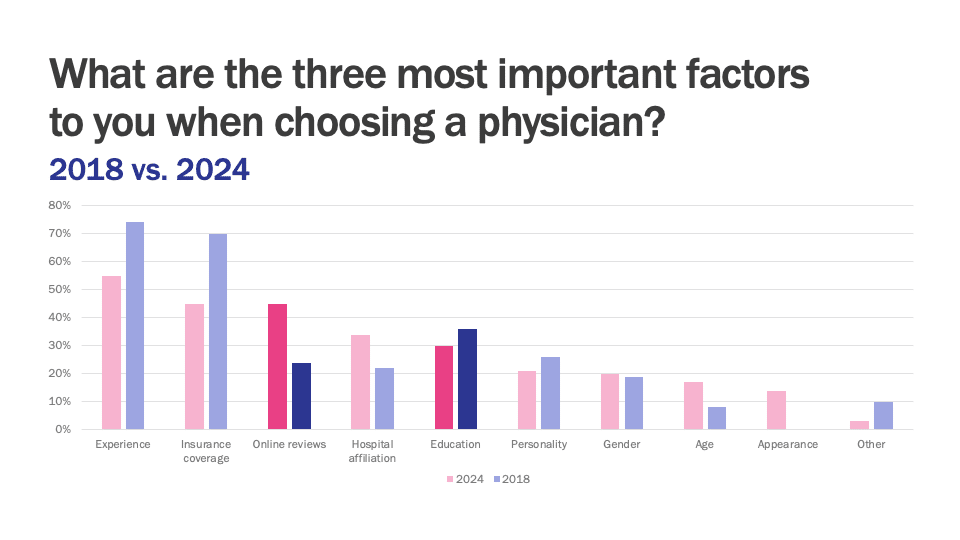Summary
- Hospital websites are patients’ top source for provider research. 26% start here, highlighting the need for accurate, detailed profiles.
- 92% of patients read bios before booking, emphasizing the importance of compelling information on experience, insurance, and reviews.
- Trust is built through relatable bios—patients value care philosophy, motivations, and plain language that connects on a personal level.
“Meet Dr. X.” Those physician bios are a core part of your healthcare marketing strategy. Done right, they’re a powerful tool for patient acquisition.
As a healthcare marketer, you want to craft a bio strategy that resonates with what patients actually want.
Which is … what, exactly?
The best physician profile, according to patients
At Aha Media Group, we work closely with providers to write outstanding, impactful profiles. So, we know what goes into a good bio. But we wanted hard data to back our approach. In the summer of 2024, we surveyed 534 people to figure out:
- Where consumers go for physician info
- What matters most when researching doctors
- How these preferences have shifted since 2018
The results might surprise you. (They surprised us.)
Ready to dive in? Read on or download the report and recommendations summary. Don’t forget to share it with your team.
Where do patients search for a new healthcare provider?
Patients today are looking for health information everywhere: Google, ChatGPT, Claude, AI Overviews, social media — you name it.
So, when they’re looking for a new provider, their search can start in several places. According to our 2024 study:
- 26% of patients visit hospital websites to find a provider.
- 19% begin on an insurance site.
- 16% start with a search engine.
But regardless of where searches for providers begin, many lead to the same place: physician profile pages on hospital websites. Patients still want to read your physicians’ bios, see photos of them, and “get to know” a provider before booking an appointment.
Your hospital website is more important than ever
Patients expect hospital websites to provide accurate, up-to-date information. Your Find-a-Doctor tool makes it easy for them to browse providers, check credentials, and feel confident in their choice.
This is a significant shift compared with a few years ago. Patients once relied on personal referrals and insurance sites, but today, they turn to hospital websites to find comprehensive details — bios, specialties, and reviews — all in one place.
What this means for your patient acquisition strategy
Patients are searching for providers everywhere online — so your provider section needs to be on point. Each physician profile has to be:
- SEO-optimized, so it’s easily found through search engines
- Rich in multimedia (so it can stand out on crowded search engine pages)
- AI-friendly, so information about your providers can be scraped and shown in AI platforms
- Mobile-friendly and easy to navigate
- Packed with the info patients care about — experience, insurance, and reviews (more on this in a minute)
How important is a provider profile for patient acquisition?
Our 2024 study shows that 92% of patients read a provider’s bio before booking an appointment. If your bios aren’t easy to find and compelling, you’re likely losing patients to competitors who’ve mastered the art.
Patients are looking for information in the bio that makes them feel comfortable and confident in booking an appointment. In 2018, only 76% of patients were reading bios. Today, it’s up nearly 17%. That’s not just a jump — it’s a clear shift in how patients choose their providers.
What elements should provider bios include?
A patient is reading through the bio about your provider — what are they looking for? What are the magic words that will encourage them to make the appointment? Our 2024 survey shows that experience, insurance coverage, and online reviews are the top bio features driving patient decisions. Simply listing a provider’s name and medical school isn’t enough — patients need practical details that build trust and confidence.
What do patients want to see in a bio?
1. Experience
55% of patients say that understanding a provider’s experience gives them the confidence to book an appointment. They care more about what a doctor has done and how they’ve helped others than where they earned their degree. Detailing specific areas of expertise, years in practice, and notable achievements is crucial for making patients feel they’re in capable hands.
Dr. X has over 30 years of experience in orthopedic surgery. She specializes in joint replacement procedures, including hip and knee replacements, using innovative, minimally invasive techniques. Her expertise has helped over 3,000 patients regain mobility and improve their quality of life.
2. Insurance coverage
44% of patients say insurance coverage is a make-or-break factor. Patients are unlikely to take the next step without knowing if their insurance is accepted. Ensure this information is front and center in every provider bio to eliminate guesswork.
3. Online reviews
44% of patients also rely on online reviews when deciding which provider to choose. Overall, 94% of patients say online reviews are important.
Positive reviews from real patients provide social proof and build credibility, making it easier for new patients to trust a provider. Up-to-date reviews included directly in bios can be a game-changer for boosting patient confidence.
As a bonus, a large volume of positive reviews indicates to search engines and AI platforms that your providers are experienced, preferred, and worth recommending in search results.
In 2018, education and hospital affiliations had more influence. But by 2024, there’s a clear shift: Patients are focused on factors that help them feel secure in their decisions. This trend reflects a broader shift in healthcare, where patients want proof of competence and reassurance from others before committing.
Does education matter?
Education is important, but it’s more of a baseline expectation now. 30% of patients say education is a factor, yet it doesn’t carry the same weight as experience, insurance coverage, or reviews. Patients assume every provider meets the basic qualifications, so they’re more focused on practical experience and validation from other patients.
Bottom line: Bottom of Form
Patients expect more than a list of credentials in today’s healthcare environment. They want to learn, at a glance:
- What’s this doctor’s experience?
- Do they take my insurance?
- What do other patients have to say?
How can you improve new patient appointment scheduling?
For patients to take the next step and book an appointment, they need to feel a strong connection and trust with the provider. According to our 2024 survey, 3 key factors stand out as essential for building that trust:
- Care philosophy
50% of patients say a provider’s care philosophy is a deciding factor. Whether patient-centered, holistic, or focused on innovative treatments, patients need to understand the approach to care. - Why the provider became a doctor
35% of patients are more likely to book if they know why the provider chose medicine. Sharing motivations helps create a human connection that fosters trust. - Shared morals and values
32% of patients are more likely to book if they share values with their provider. It’s not just about medical expertise anymore — patients want doctors who align with their values.
A well-written bio is essential to this approach. It’s part of the larger “story” of your providers, which should also include direct quotes, videos, linked blog posts, and patient testimonials. All of this content should convey the doctor’s care philosophy and values.
Let’s write it: Your framework for a provider bio
To create bios that convert, include what patients care about most:
- The provider’s “why”: Convey their care philosophy, why they became a doctor, and their values.
- Experience: Clearly outline a provider’s specialties, years of practice, and significant achievements. These build trust by showing practical competence.
- Insurance coverage: Make sure patients can easily determine if their insurance is accepted. This is often the first thing they want to know.
- Online reviews: Include real, recent patient reviews to add social proof and help patients feel more confident in their choices.
- Photos or videos: 77% of patients look for visual content before booking — up from 50% in 2018. A professional headshot or video helps humanize the provider and makes them more relatable.
- Education, credentials, hospital affiliation: While these are not as important to patients as they once were, they are industry standard.
See examples of physician bios that meet patients’ needs.
Do’s and don’ts of your Find-a-Doc strategy
Provider bios are often the first impression patients get of your medical team. With 92% of people reading them before making an appointment, sloppy profiles aren’t an option. The problem? Bios are too often an afterthought, leading to confusing details, poor writing, and a frustrating experience for potential patients.
To avoid these missteps, we’ve pulled together a list of do’s and don’ts. Whether you’re onboarding new doctors, managing profiles across locations, or optimizing for SEO and AI search, these tips will help you create bios that inform, engage, and convert.
Do:
- Have a bios strategy
- Set up a workflow
- Use a template
- Keep it patient-focused
- Prioritize bios during a major update
Don’t:
Do: Treat your bio strategy like any other content strategy
A good bio strategy isn’t a “set it and forget it” deal. Approach it with care, just like you would any other content. Follow these tips from our account team:
- Prioritize high-traffic profiles: Like SEO pages, start with the profiles that get the most traffic.
- Optimize for SEO: Use keywords people are actually searching for. “Cardiologist in Dallas, TX” will drive more clicks than “electrophysiologist.”
- Optimize for AI: People are using platforms like ChatGPT and Claude to look for providers. Structure your content and schema so it can be easily interpreted and distributed by AI bots.
- Know your competition: Check out how your competitors present their provider bios and use that data when explaining your template to stakeholders.
- Understand the customer journey: How are patients finding you? Are they searching for a primary care provider or a specialist? They’ll enter your site in different ways — make sure profiles are easy to find from multiple angles.
Don’t forget SEO cross-linking opportunities. Link to related blogs, patient stories, or even social media. And link the other way, too — from program and clinic pages to physician profile pages. This helps improve discoverability and patient engagement.
Do: Set up a clear workflow for profile creation and publishing
The bio-writing process shouldn’t be ad hoc or left to guesswork. A structured workflow ensures consistency and efficiency, especially when new providers join the organization. Here’s how to get it right:
- Onboard new providers with their bio in mind
Set expectations from the start. During hiring or onboarding, let providers know their bio will be part of their public profile. Include this information in their welcome packet or orientation so they’re aware right away. - Assign responsibilities
- Information collection: Assign HR, marketing, or an external partner like Aha Media to gather bio info from the provider. (One of our clients sets up an interview between new clinicians and our writer as an onboarding step.) Inform the provider from the beginning that the final version might be paraphrased or edited for clarity, tone, or length.
- Multimedia production: Quality headshots and videos of providers help prospective patients connect with the physician, but these assets take time to create. Build it into your workflow to create visual assets for profile pages — and plan to update them throughout a physician’s tenure. (For example, you may need to replace a video from 2018 discussing the “latest” treatment techniques.)
- Content writing: Once you collect the raw info (from an interview, questionnaire, or CV), assign a writer to craft the bio. This can be an in-house content team or a trusted external resource. The writer ensures tone, style, and format are consistent with your bio template. Need help? Here’s a guide on how to write bios that resonate with patients.
- Review and approval: Set up a clear approval chain. Providers should review their bios. Avoid bottlenecks by having a set review timeline (so it doesn’t linger on someone’s desk for weeks).
- Publishing: Designate someone (likely from marketing or web content management) to publish the bio across relevant platforms — like your site, Google Business profiles, and third-party tools.
- Automate what you can
Consider using content management tools that allow for automatic updates or workflows. These tools make it easier to publish and revise bios across multiple channels. They also streamline the process if a provider’s credentials change, or they want to update their volunteer work. - Ongoing updates
Bio updates shouldn’t be one-and-done. Assign a team to regularly audit and update profiles, especially for long-term staff who may have changed roles, gained new certifications, or participated in noteworthy activities like research or conferences.
Do: Standardize your provider bios with a template
Create a template for provider bios to keep things consistent across your organization. It’s not just about the format — it’s also about deciding exactly what information you need and how to present it:
- Degrees: Will you only include relevant medical degrees or also fun, unrelated ones (like that BA in contemporary dance)?
- Credentials: Have consistent rules for listing degrees like PhDs, DOs, or RPhs.
- Organizational memberships: If a provider sits on a prestigious medical board, great — include it. But if the field doesn’t apply, remove it rather than leaving it blank or marked “N/A.”
If you’re using a third-party Find-a-Doc tool for profile management, know what fields are available from the beginning. Understanding the tool’s capabilities upfront will save you a lot of hassle later.
Do: Let providers know who the bio is for
If the bio is for patients, it needs to be patient-friendly. Some providers might gear their bios toward their peers, particularly in academic settings. That’s great if you want to appeal to fellow academics — but to resonate with patients, the tone and content have to be accessible and focused on patient needs.
Do: Prioritize bios during major enterprise transitions
Merging locations or forming new partnerships can leave bios as an afterthought in the bigger transition plan. Don’t let that happen. Given that 92% of people look at bios before booking an appointment — and most of those searches happen on your site — prioritizing provider profiles is essential.
You’re putting a lot of work into a shiny new design, so don’t forget these crucial patient touchpoints.
Don’t: Expect providers to write their own bios
Leaving the writing to providers can result in inconsistent styles, lengths, and quality. Not everyone is a great self-promoter or writer. We’ve seen less-than-stellar results when bios are published verbatim from a questionnaire.
Instead, ask the provider to fill out a questionnaire or send a CV, then hand it to a writer (with the template). This ensures a consistent tone, style, and structure. And a reminder: Let your stakeholders know upfront that their words might be paraphrased or rewritten to fit the template.
Don’t: Ignore external provider profiles
Your website isn’t the only place where your providers’ profiles live. They’re likely on Google Business, Zocdoc, Healthgrades, and other platforms. While it might not be your job to manage all of these, you should document them. Consistency across all channels is tough, but it starts with knowing what’s out there.
Share this data with your team
Download the summary of these findings along with a one-page how-to guide and share it with your department.
